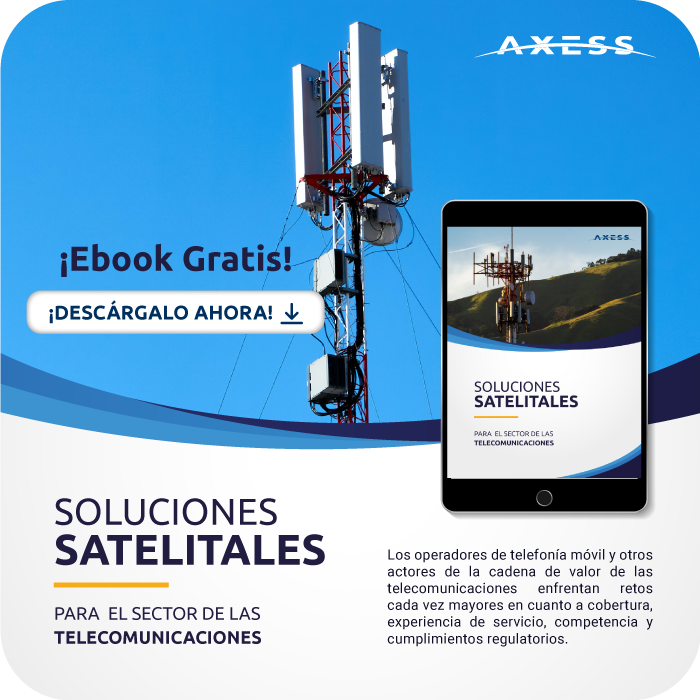
Satellital Networks
19 May, 2022
The internet of things IoT and satellite connectivity
19 May, 2022In the global telecommunications system, the use of artificial satellites to provide satellite communication links between various points on earth plays a vital role. There are approximately 5,600 artificial satellites orbiting the Earth, relaying analog and digital signals carrying voice, video, and data to and from one or various locations around the world.
Communication satellites provide the bridges for a series of specialized markets in commercial and private telecommunications, which create ties between nations, strengthening worldwide interconnectivity.
Satellite communications has two main components: the ground segment, which consists of fixed or mobile transmission, receiving, and ancillary equipment, and the space segment, which is primarily the satellite itself.
A typical satellite link involves the transmission or uplink of a signal from a ground station to a satellite, which receives and amplifies the signal and relays it back to Earth, where ground stations and terminals receive and amplify it again. Satellite receivers on the ground include fixed satellite equipment, mobile receiving equipment on aircraft, satellite phones and portable devices.
How does a satellite work?
A communications satellite is an independent system that orbits in space. It provides its own electrical power supply, maintains its altitude, withstands the harsh environment of space, and ensures that the mission devices function normally during their required lifetime.
The design of a satellite consists of the conceptual design, the preliminary design and the critical design, based on a plan of satellite communications systems, in addition to the design of performance requirements and the construction of various manufacturing models (BBM, board model); EM, engineering model; PFM, proto flight model, and FM, flight model).
The satellite must pass a simulated thermal vacuum test in a space chamber, as well as vibration and other necessary tests, before being loaded and launched on a rocket.
Main components of a Satellite
- Communications system: includes the antennas and transponders to receive and retransmit signals.
- Power System: Contains solar panels that provide power; in that sense, during the entire useful life of the satellite, its main source of energy is sunlight. However, it also has batteries on board to provide power when the Sun is blocked by the Earth.
- Propulsion System – Provides the rockets that propel the satellite and is needed to get to the correct orbital location and make occasional corrections to that position; a satellite in geostationary orbit can drift up to one degree each year from north to south or east to west, due to the gravitational attraction of the Moon and Sun. The maintenance of the orbital position of a satellite is called “station maintenance” and, the corrections, “attitude control”. The lifespan of a satellite is determined by the amount of fuel it has to power these thrusters. Once the fuel runs out, the satellite eventually drifts into space and stops working, becoming space junk.
Satellites operate under extreme temperatures of -150°C (-238°F) to 150°C (300°F) and can be subject to radiation in space, therefore satellite components that would be exposed are shielded with aluminum and other radiation resistant materials.
A satellite’s thermal system protects its sensitive electronic and mechanical components and keeps it at the optimum temperature to guarantee its continuous operation. Likewise, it also protects the sensitive components of the satellite from extreme changes in temperature; activates the cooling mechanisms when it gets too hot and the heating systems when it gets too cold.
The telemetry and control system of a satellite is a two-way communication link between the satellite and the Earth. This allows a ground station to track a satellite’s position and control its propulsion, temperature, and other of its systems. It can also monitor temperature, electrical voltages, and other key parameters of a satellite.
Communication satellites range from microsatellites—weighing less than a kilogram (2.2 pounds)—to large satellites—more than 6,500 kilograms (14,000 pounds). Advances in miniaturization and digitization have substantially increased the capacity of satellites over the years. Early Bird had only one transponder capable of sending only one television channel, and by contrast, the Boeing 702 series of satellites can have more than 100 transponders; using digital compression technology, each transponder can have up to 16 channels, providing more than 1,600 television channels via satellite.
The orbits of satellites
Satellites operate in three different orbits:
- Low Earth Orbit (LEO): They are positioned at an altitude between 160 km to 1,600 km (100 to 1,000 miles) above the Earth.
- Mid Earth Orbit (MEO): They operate from 10,000 to 20,000 km (6,300 to 12,500 miles) from the Earth.
- Geostationary or Geosynchronous Orbit (GEO): They are located at 35,786 km (22,236 miles) above the Earth, where they complete an orbit in 24 hours and therefore remain fixed at one point.
Similarly, only three GEO satellites are needed to provide global coverage, while 20 or more satellites are needed to cover the entire Earth from LEO and 10 or more in MEO. Also, communication with satellites at LEO and MEO requires ground tracking antennas to guarantee seamless inter-satellite connection.
A signal bouncing off at a GEO satellite takes approximately 0.22 seconds to travel at the speed of light from Earth to the satellite and back. This delay poses some problems for applications such as voice and mobile telephony services, which is why most of these services usually use LEO or MEO satellites to avoid signal delays. GEO satellites are generally used for broadcast and data applications, due to the fact that they can cover a larger area on the ground.
Generalities on the construction of satellites
In space there are more than 5,000 satellites from Earth and, currently, each of them has a useful life of between 5 and 15 years.
They are classified into two categories:
- Communication devices: allow the transmission of radio and television signals between two specific areas of the planet; these serve as a method to “enlighten” certain areas of the world.
- Observation devices: they are limited to collecting data and information.
Building a satellite is a high-cost task due to the materials required in the manufacturing process, particularly due to the minimum specifications to be met. These devices need to withstand the radiation from space, be sufficiently resistant to the pressure of traveling through space at a constant speed of 700 kilometers per hour and, in addition, have adequate strength so as not to be damaged by possible impacts from space debris or asteroids of smaller size.
To build a satellite, it is generally used:
- Kevlar-type materials, which do not melt until they reach very high temperatures.
- Carbon fiber, which, due to its physical properties, has high resistance.
- Titanium, due to its high strength against the effects of oxidation.
- Aluminum, because it is recyclable and light weight.
- Carbon nanotubes, remarkable for their strength.
Also, before starting the construction, it is necessary to determine the function of the satellite, since not all devices can be created in the same way. Each one must be assigned a specific communication channel and, furthermore, it must be properly designed in order to broadcast the appropriate signals, accordingly to the chosen transmission format. In this sense, they are classified according to the orbit: low, mid or geostationary transfer.
AXESS, as one of the specialized companies and leader in this industry, uses communication satellites to provide users with satellite Internet services. Likewise, the service is offered to some representatives of the business sector (fishing, oil, mining and banking), which have connectivity requirements in remote areas.
Do you have any questions or want to know more about this topic?
At AXESS Networks we are always ready to provide you with key solutions, tailored to your needs and individual requirements, regardless of the economic sector or industry to which your company belongs to, or the area or operating conditions in which we must be at.
We are experts in satellite connectivity and in providing added value to support production. If you want more information about our solutions and services,please send us your information to marketing@axessnet.com






